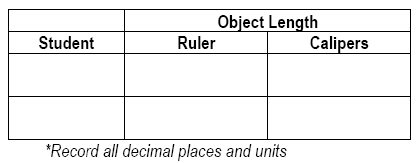Lab Investigation 1 - What is the best practice for laboratory measurement?
Using Laboratory Equipment and Glassware
1
The chemistry laboratory is equipped with top loading balances and analytical balances. On your lab table you will find an object. We would like you to weigh the object on both types of balances. Do this individually using a different set of balances so that you can compare values with your partner.
-
aHow do the values for Top loader vs. Analytical compare?
-
bHow do values compare between students? Identify some reasons for any differences.
2
Measure 8 mL of water in the 10 mL graduated cylinder and in the 25 mL graduated cylinder.
-
aTo how many decimal places can volume be measured with the 10 mL graduated cylinder? Circle one: 0.1 0.01 0.001
-
bWrite the volume using the correct number of decimal places and units.
-
cTo how many decimal places can volume be measured with the 25 mL graduated cylinder? Circle one: 0.1 0.01 0.001
-
dWrite the volume using the correct number of decimal places and units.
3
Measure 10 mL of water in the small beaker provided, then transfer the water to the 10 mL graduated cylinder (smallest one). Read the graduated cylinder to two decimal places.
-
aWhat volume do you have in the graduated cylinder? *Record all decimal places and units.
-
bWhy would the volume be different when measured with the 10 mL graduated cylinder versus the beaker?
-
cWhat can you infer about the volume accuracy using a beaker?
4
Use the ruler and calipers provided to measure the length of the object on your lab table. Do this individually.
-
aTechnically you can measure to the 0.01 with both the ruler and the caliper. Why would you choose to use the calipers?
-
bHow do values compare between students? Identify some reasons for any differences.
5
What is the best practice for laboratory measurement?


